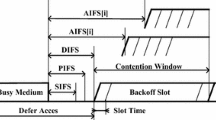Abstract
Vehicular Adhoc Networks (VANET) was created to facilitate and enable inter vehicular communication. One of the most challenging problems affecting the feasibility of VANET is the problem of high mobility of the nodes resulting in an induced Doppler Shift (DS) in the carrier frequency at the receiver end. The work presented in this paper proposes a solution to mitigate the effect of DS affecting the VANET environment. Based on the Direct Derivation Method (DDM) derived from the principle of communication theory, an Improved DDM (IDDM) concept, analysis and design is developed and explored. Several critical tests are performed and it was demonstrated that not only the IDDM response exhibits the BER threshold limit described by the IEEE 802.11 standard; the approach offers for the same SNR value, a throughput improvement of up to 66.66 % and an improved BER response of more than 25 % compared to the DDM and Constant (Cte). A performance analysis also demonstrated that not only IDDM performs faster, it equally offers considerable improvement in term of efficiency over the DDM approach.

















Similar content being viewed by others
References
Campolo C, Molinaro A (2010) Data rate selection in WBSS-based IEEE 802.11p/WAVE vehicular ad hoc networks. In: Communication Systems Networks and Digital Signal Processing (CSNDSP), 2010 7th International Symposium, 21-23 July 20, 2010. E-ISBN:978-1-86135-369-6 http://ieeexplore.ieee.org/stamp/stamp.jsp?tp=&arnumber=5580384&isnumber=5580291
Dulmage J, Fitz MP, Cabric D (2010) A Modulation Dependent Channel Coherence Metric for VANET Simulation Using IEEE 802.11p. IEEE 71 st, Vehicular Technology Conference (VTC 2010-Spring); pp 1116–1121. doi:10.1109/IVS.2010.5548077
Feukeu EA, Djouani K, Kurien A (2012) Doppler effect analysis and modulation code derivation. Procedia Comp Sci 10:1032–1038. doi:10.1016/j.procs.2012.06.143
Feukeu EA, Djouani K, Kurien A (2013) Compensating the effect of Doppler shift in a vehicular network, AFRICON,9-12 Sept 2013. pp 1–7. doi:10.1109/AFRCON.2013.6757685
Feukeu EA, Djouani K, Kurien A (2015) Performance evaluation of the ADSA in a vehicular network: MAC approach in IEEE 802.11p. J Ambient Intell Humaniz Comput 6:351–360. doi:10.1007/s12652-015-0268-9
Fuqin X and Monty A (2001) The effect of Doppler frequency shift, frequency offset of the local oscillators, and phase noise on the performance of coherent OFDM receivers [microform]/Fuqin Xiong, Monty Andro, [Cleveland, Ohio]: Hanover, MD, National Aeronautics and Space Administration, Glenn Research Center; 2001. http://ntrs.nasa.gov/archive/nasa/casi.ntrs.nasa.gov/20010049375.pdf (Accessed 17 November 2011)
IEEE Std 802.11 MAC and PHY specifications (2007) IEEE standard for information technology—telecommunications and information exchange between systems—local and metropolitan area networks—specific requirements—part 11: wireless LAN medium access control (MAC) and physical layer (PHY) specifications, IEEE Std 802.11-2007 (Revision of IEEE Std 802.11-1999), pp 1–1076. doi:10.1109/IEEESTD.2007.373646
Jiang D, Chen Q, Delgrossi L (2008) Optimal data rate selection for vehicle safety communications. Proceedings of the fifth ACM international workshop on VehiculAr Inter-NETworking. San Francisco, California, USA: ACM. doi:10.1145/1410043.1410050
Khaldoun A, Utayba M, Nizar A (2011) Doppler Shift Impact On Vehicular Ad hoc Network, Canadian Journal on Multimedia and Wireless Networks 2:3
Khlass A, Ghamri-Doudane Y, Gacanin H (2011) Combining Cooperative Relaying and Analog Network Coding to Improve Network Connectivity and Capacity in Vehicular Networks, in Proc. of IEEE Global Telecommunications Conference (GLOBECOM 2011), pp 1–5. doi:10.1109/GLOCOM.2011.6133777
Lawrey E (1997) The suitability of OFDM as a modulation technique for wireless telecommunications, with a CDMA comparison. Bachelor of Engineering with Honours, James Cook University; 1997
Lee BS (2008) Doppler effect compensation scheme based on constellation estimation for OFDM system. Elect Lett 44(1):38–40. doi:10.1049/el:20082751
Liu B, Pi Y, Yang X, Min R, Wu W (2009) A novel approach to improve Doppler tolerance of polyphase code. Int Conf Commun Circ and Syst ICCCAS 2009:558–561
Paridel K, Mantadelis T, Yasar A, Preuveneers D, Janssens G, Vanrompay Y, Berbers Y (2012) Analyzing the efficiency of context-based grouping on collaboration in VANETs with large-scale simulation. J Ambient Intell Humaniz Comput 5:475–490. doi:10.1007/s12652-012-0115-1
Shie-Yuan W, Chih-Che L, Kuang-Che L, Wei-Jyun H (2009) Improving the Channel Utilization of IEEE 802.11p/1609 Networks,” in Proc. of IEEE WCNC. doi:10.1109/WCNC.2009.4917753
Tenorio S, Spence P, Garriga B, Lopez J, Garcia A, Arranz M (2010) 3G HSPA for Broadband Communications with High Speed Vehicles,” in Proc. of IEEE 71s Vehicular Technology Conference (VTC 2010-Spring, pp. 1–5, May 2010). doi: 10.1109/VETECS.2010.5493957
US Department of Transportation (2006) Vehicle safety communications project final report. Nat Highw Traffic Safety Adm. DOTHS 810:591
Wang SY, Chou CL, Liu KC, Ho TW, Hung WJ, Huang CF, Hsu MS, Chen HY, Lin CC (2009) On Multi-hop Forwarding over WBSS-based IEEE 802.11(p)/1609 Networks,” in Proc. of IEEE PIMRC. doi:10.1109/PIMRC.2009.5450153
Wang C, Shi D, Xu X, Fang J (2015) An anonymous data access scheme for VANET using pseudonym-based cryptography. J Ambient Intell Humaniz Comput 1–9. doi:10.1007/s12652-015-0301-z
Xue S, Xiong L, Yang S, Zhao L (2015) A self-adaptive multi-view framework for multi-source information service in cloud ITS. J Ambient Intell Humaniz Comput:1–16. doi:10.1007/s12652-015-0316-5
Acknowledgments
This work was supported by Tshwane University of Technology/French South African Institute of Technology and National Research Foundation (NRF) via the Freestanding Fellowship program.
Author information
Authors and Affiliations
Corresponding author
Rights and permissions
About this article
Cite this article
Feukeu, E.A., Djouani, K. & Kurien, A. Doppler Shift Mitigation in a VANET using an IDDM approach. J Ambient Intell Human Comput 7, 321–332 (2016). https://doi.org/10.1007/s12652-016-0365-4
Received:
Accepted:
Published:
Issue Date:
DOI: https://doi.org/10.1007/s12652-016-0365-4




